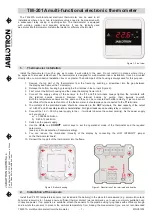
801326 Rev.01 June 2010
DMQC & DMC SERIES PTAC SUPPLEMENTAL INSTALLATION INSTRUCTIONS
REMOTE THERMOSTAT OPTION - COOLING WITH OR WITHOUT ELECTRIC HEAT
GENERAL
This supplement contains information specific to
remote thermostat DMQC and DMC PTAC models
that have no “OFF” position marked on the unit dial
plate. Please also refer to the general Installation
Operation and Maintenance Manual included with the
unit.
THERMOSTAT SELECTION:
Except for fan speed selection, the unit is completely
controlled by a wall thermostat mounted at a remote
distance from the unit. Any standard single-stage 24
volt heat/cool thermostat intended to control a gas
heating unit with cooling can be made to work with
the unit; this includes automatic changeover and
electronic thermostats. The thermostat will
automatically maintain the temperature in the room,
based on the setting pre-set by the user.
A simple room thermostat is a switch that directs 24
volt power from its “R” terminal to its W, Y, and G
terminals, according to the function being demanded
by the user. Since it is a just a switch, it does not
consume power, and thus requires only 4 wires for
control. However, electronic thermostats need to be
powered - some use batteries or other methods and
hence need no more than 4 wires. However,
thermostats that need to be powered with the 24 volt
source will need an additional connection to be made
to the thermostat “C” or “Common” terminal,
especially if its display is backlit. If this is the case,
please order the additional Black lead that will insert
into the unit’s low voltage connector, Part No.
18BK23Y-024. This will allow a 5-wire thermostat
connection.
THERMOSTAT LOCATION:
Proper functioning of the thermostat depends on
accurate room temperature sensing. Be conscious of
locating the thermostat where temperatures near the
thermostat are not representative of room
temperature. For example, do not install the
thermostat where it is subjected to direct sunlight,
other sources of heat, or cold drafts, including air
discharged from a supply air register. A common
error is not sealing the hole in the wall where the
thermostat cable passes through directly behind the
thermostat body. Air from behind the wall can
drastically affect the temperature sensed by the
thermostat.
CHASSIS INSTALLATION
Follow the first four steps of “Chassis Installation”
outlined in the standard unit Installation Instructions,
and then proceed as follows:
DO NOT PLUG IN THE POWER CORD YET.
A six-position connector has been provided with 24”
leads to make the low voltage wiring connections,
and to provide a quick disconnecting means when
removing the chassis from the sleeve for servicing.
Make the low voltage wiring connections to the
remote thermostat according to the specific wiring
diagram affixed to the heating/cooling chassis.
IMPORTANT:
208-230 volt units are factory-wired to
the 240 volt tap on the primary side of the 24 volt
transformer for 230 volt operation. For 208 volt
installations the designated wire must be moved from
the 240 volt to the 208 volt tap on the transformer
(see unit wiring diagram).
Install the front panel by engaging the hooks into the
slots in the side flanges of the sleeve. Install the filter
per the standard unit instruction manual and then
plug in the unit.
OPERATING INSTRUCTIONS
THERMOSTAT OPERATION
In addition to controlling room temperature, the room
thermostat is also used to select whether the unit is
to be in heating or cooling mode, whether the system
is to be ON or OFF, and to set whether the fan is to
run continuously, or to cycle with heating or cooling
demand.






















